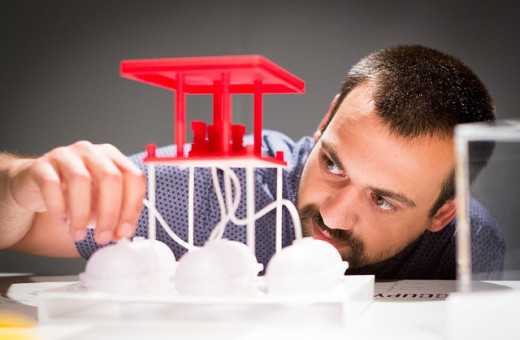1 My current practice is a kind of hybrid formed by twists and turns, education and experiences. My background is in graphic design and typography, which I studied in the Netherlands (2006). From there I took a more “interactive” turn, designing for the web or programming sound-reactive installations and visuals. I then moved to London to study at the Royal College of Art (RCA) in the Design Interactions Department (2010). There I got interested in science and technology as a subject rather than just using them as tools; I started using design to explore and question their role in society and culture.
Elements and leftovers from this trajectory are present in different combinations in the various aspects of my practice today. I work on applied projects, for example, as a consultant for Microsoft Research in Cambridge where I am helping to design a modelling tool for biologists. I also do more speculative projects, such as Blueprints For The Unknown, an EU-funded project exploring the impact of synthetic biology on society that I ran at the RCA between 2011 and 2015.
There are different aspects to my practice, but they all include science and technology, design and research in some capacity. I also enjoy teaching and running workshops. It all forms a somewhat coherent whole where things feed off each other sometimes in unexpected ways.
2 I recognise myself in the umbrella term “speculative design” but it means so much and so little at the same time. I think it is more useful to consider it as a set of ingredients and methods that people can use (or not) in making their own “sauce”. For example, this could mean an installation suggesting a possible technological future, documentary film about historical re-enactment or workshop around fictional prototypes. These all fall under the same umbrella but are very different things, with different aims and contexts. Some designers and artists have built their whole practice around “speculation” while some students only use it as a testing ground to experiment during their studies. It is not always useful to group all of this together. I hope that the critique of this field will become more precise and start dissecting why a specific approach or project is or is not successful in its context.
I have been practicing some form of “speculative design” for some time now but there are still many questions I am keen to clarify. That is one of the main reasons I have recently embarked on a PhD, to try and better articulate what “speculation” means in my own practice. One of the big criticisms is that this work mainly exists in museums and galleries; I am looking forward to experimenting with other modes of dissemination, ones that infiltrate the current media landscape in more varied and playful ways.
3 As with any independent practice, things take a long time to set up. I think building a viable practice is a design task in itself, and not an easy one. It is definitely possible but does require some level of compromise, navigating funding structures, grants, etc. In some ways this ends up in shaping the practice as well.
In my case, it was a matter of balancing the more applied work that pays better with the more speculative projects, which are harder to fund. But, there is never a clear cut between “money jobs” and “interesting projects”. Some commercial projects have brought a lot to the practice on an intellectual level. The ideal balance for me is when you find ways of earning money that also fit within your interests and goals.
